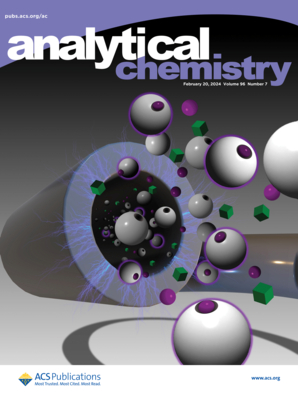基于普鲁士蓝纳米酶的干量尺反射法多重检测低分子量代谢物。
IF 6.7
1区 化学
Q1 CHEMISTRY, ANALYTICAL
引用次数: 0
摘要
慢性疾病及其相关的肝肾功能障碍构成严峻的全球健康挑战,严重影响生活质量,同时增加发病率和死亡率。在中国,有效管理CD的一大瓶颈在于缺乏负担得起且高效的初级保健点检测(POCT)方法。为了解决这一问题,我们开发了一种基于普鲁士蓝(PB)纳米酶的干试纸反射测量平台,用于探测与高血糖、高尿酸血症、高胆固醇血症和高脂血症相关的关键代谢标志物。以乙二醇为拥挤剂和防污添加剂,成功地实现了PB纳米酶的克级合成。该纳米酶表现出优异的催化性能,其催化活性比辣根过氧化物酶(HRP)高约67倍,而单次测试成本比基于HRP的组合降低高达55.9倍。通过将PB纳米酶与底物特异性氧化酶、显色酶和质子供体共固定,形成了具有相当成本效益的四重传感条带。这使得同时检测葡萄糖,尿酸,胆固醇,甘油三酯只使用50 μL的样品。与安装在智能手机上的检测器集成,载玻片成功地在6分钟内对血清模拟样品进行多路分析,表现出极好的重复性(总体变异系数<5%)。葡萄糖、尿酸、胆固醇、甘油三酯的检出限分别为0.52 mM、0.025 mM、0.18 mM和0.425 mM,线性范围分别为2 ~ 30 mM、0.1 ~ 1.0 mM、1 ~ 10 mM和0.5 ~ 7 mM。这种纸上方法具有很强的优势,可以扩展到其他CD指标(例如,天冬氨酸、丙氨酸转氨酶、尿素、肌酐),促进生物杂交POCT解决方案在更广泛的临床应用。本文章由计算机程序翻译,如有差异,请以英文原文为准。
Prussian Blue Nanozyme-Based Dry-Dipstick Reflectometry for Multiplex Detection of Low Molecular Weight Metabolites.
Chronic diseases (CDs) and their associated hepatic and renal dysfunctions pose grim global health challenges, severely compromising quality of life while increasing morbidity and mortality rates. In China, a big bottleneck in effective CD management lies in the lack of affordable and efficient point-of-care testing (POCT) methods at the primary care level. To address this, we developed a Prussian blue (PB) nanozyme-based dry dipstick reflectometric platform for probing key metabolic markers associated with hyperglycemia, hyperuricemia, hypercholesterolemia, and hyperlipidemia. Gram-scale synthesis of PB nanozymes was successfully secured using ethylene glycol as a crowding agent and antifouling additive. The nanozyme showed superb catalytic performance, with an activity approximately 67-fold higher than that of horseradish peroxidase (HRP), while reducing the per-test cost by up to 55.9-fold compared to the HRP-based ensemble. A considerably cost-effective quadruple sensing strip was shaped up by coimmobilizing PB nanozymes with substrate-specific oxidases, chromogen, and proton donors. This enabled the simultaneous detection of glucose, uric acid, cholesterol, and triglycerides using only 50 μL of the sample. Integrated with a smartphone-mounted detector, the slides succeeded in multiplexed assay of serum-simulated samples within 6 min, demonstrating superb repeatability (overall coefficients of variation <5%). The detection limits were 0.52 mM for glucose, 0.025 mM for uric acid, 0.18 mM for cholesterol, and 0.425 mM for triglycerides, with corresponding linear ranges of 2-30, 0.1-1.0, 1-10, and 0.5-7 mM, respectively. This on-paper approach holds strong strength for expanding to other CD indicators (e.g., aspartate, alanine aminotransferase, urea, creatinine), fostering biohybrid POCT solutions for broader clinical applications.
求助全文
通过发布文献求助,成功后即可免费获取论文全文。
去求助
来源期刊

Analytical Chemistry
化学-分析化学
CiteScore
12.10
自引率
12.20%
发文量
1949
审稿时长
1.4 months
期刊介绍:
Analytical Chemistry, a peer-reviewed research journal, focuses on disseminating new and original knowledge across all branches of analytical chemistry. Fundamental articles may explore general principles of chemical measurement science and need not directly address existing or potential analytical methodology. They can be entirely theoretical or report experimental results. Contributions may cover various phases of analytical operations, including sampling, bioanalysis, electrochemistry, mass spectrometry, microscale and nanoscale systems, environmental analysis, separations, spectroscopy, chemical reactions and selectivity, instrumentation, imaging, surface analysis, and data processing. Papers discussing known analytical methods should present a significant, original application of the method, a notable improvement, or results on an important analyte.
 求助内容:
求助内容: 应助结果提醒方式:
应助结果提醒方式:


